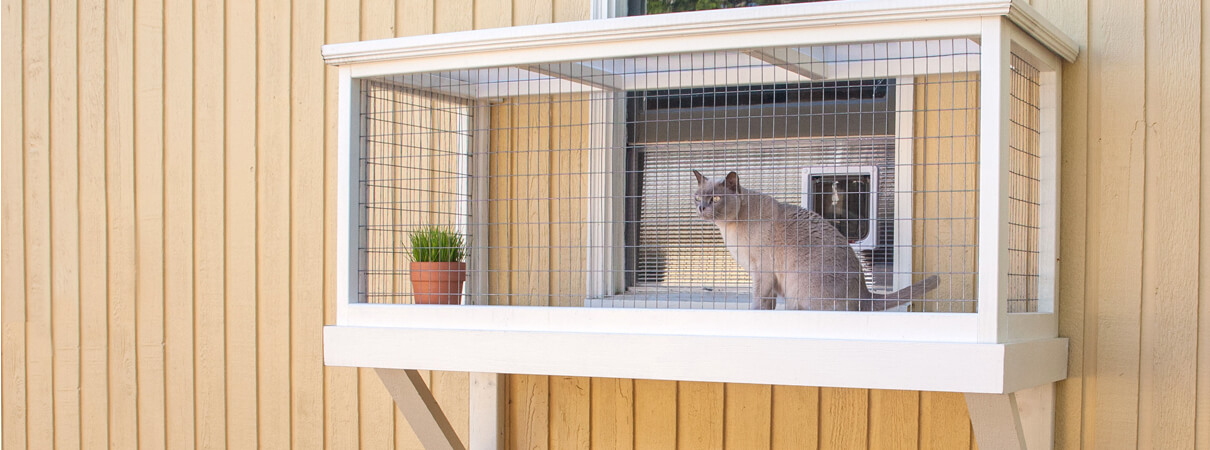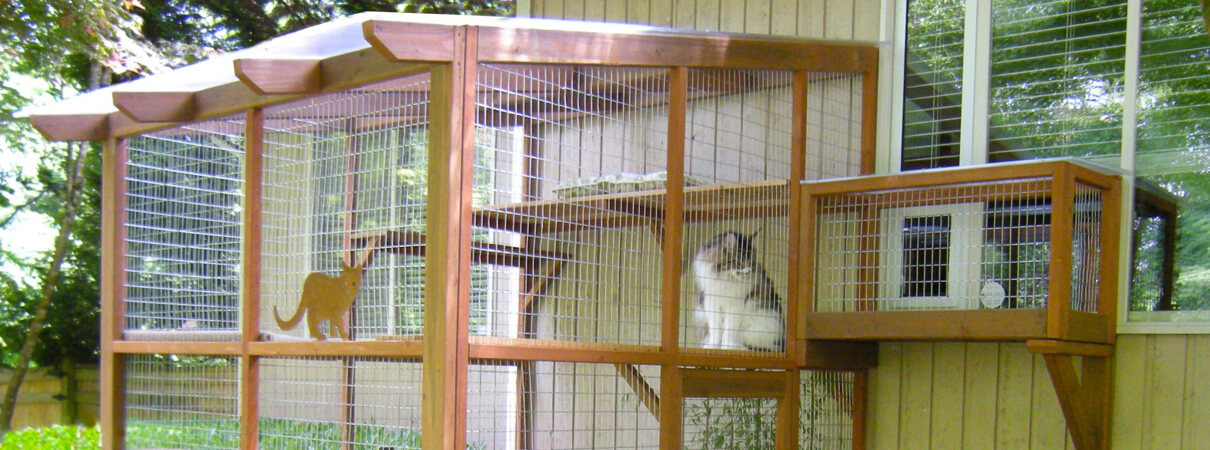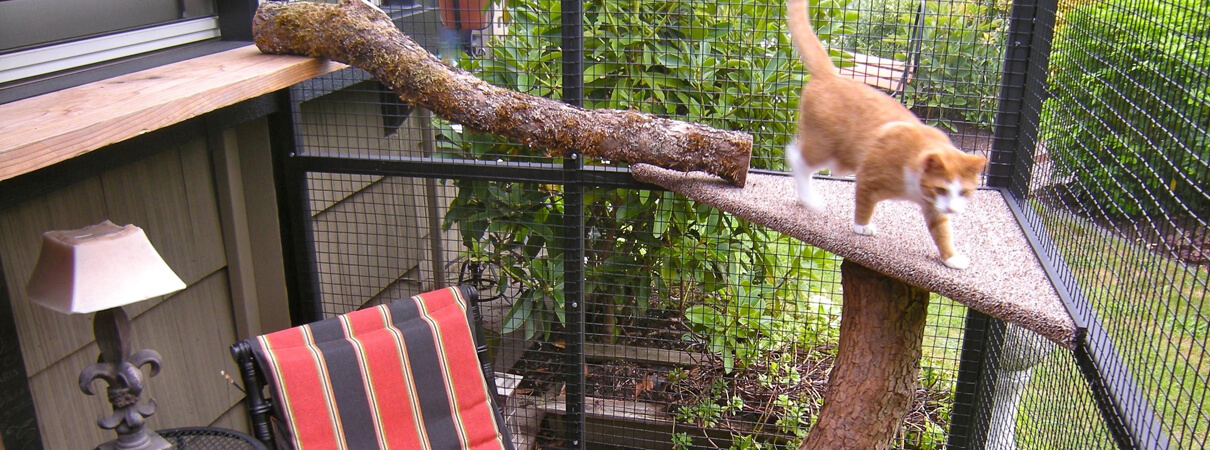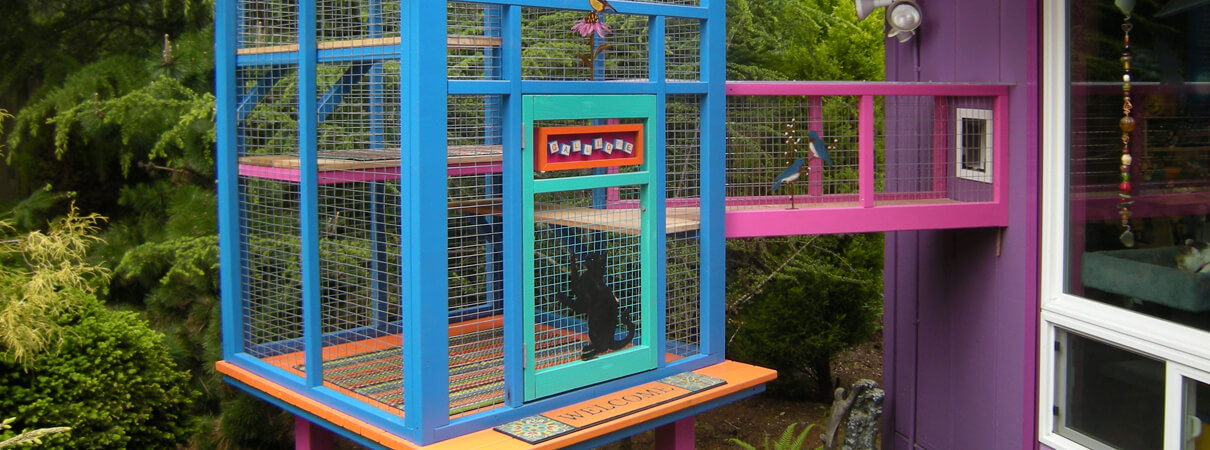'Life is Good in a Catio'
Cynthia Chomos, the founder of Seattle-based Catio Spaces, talked with Grant Sizemore, ABC's Director of Invasive Species Programs, about why catios are one great way to keep your feline friend happy and safe — and the role catios and cat owners can play in bird conservation.
What is a catio?
It's an escape-proof, outdoor enclosure or “cat patio” to keep cats safe outdoors while they're enjoying the enrichment and stimulation of nature. Available in a variety of sizes and designs, catios can be added to a window, porch, patio, deck, or garden. Cats enter through a cat door installed in a window, wall, or door with 24/7 access. (Cat doors can be locked at night as desired.) Catios can be as small as a window box or large enough for humans to enjoy too.

Photo by Catio Spaces
Tell us about your cat Serena, who inspired you to found Catio Spaces.
Catio Spaces was inspired several years ago by my adopted tabby, Serena, who has since become my quality assurance expert and a “catio queen.” (She now has 4 catios!) Being an avid gardener and nature lover, I wanted her to be able to safely enjoy the outdoors with me, so I converted my patio into a catio. While sitting in it with her one morning, I had a flash of inspiration to start Catio Spaces and combine my expertise as a Feng Shui consultant, designer, and general contractor.
One thing led to another, and I now design and build custom catios in the Seattle area together with my team of carpenters. I also offer a variety of DIY plans so cat parents around the country can build a catio or hire a local carpenter to build one of our plans for them. Since Serena prefers to be the “one and only” cat in my home, I donate 10 percent per plan purchase to help support animal welfare organizations. I feel blessed every day to have Serena as my companion, and it's a joy to be making a difference in both my two-legged and four-legged clients' lives.
How much do catios cost to buy or build?
A variety of resources are available, including DIY plans ($50 plus materials), pre-made kits ($600-$2,000+), and professionally-built custom models ($2,000+ based on the design and size). From simple to sublime, there are many ways to create a safe, outdoor catio space. An existing balcony or porch can be enclosed to make a low-cost version. If space is limited, smaller but taller catios are another option, since cats enjoy exploring vertical spaces.
How handy do I have to be to build one myself? What materials would I need?
Anyone with basic carpentry or home improvement skills can build a catio. Basic materials include framing lumber, fencing wire, staples, cedar shelves, and roof options including wire or polycarbonate roof panels for year-round weather protection. Flooring options include grass, decking, paving stones, or outdoor carpet covering a wood floor. Materials can be purchased at a local home improvement or lumber store. Recycled materials are another low-cost option.

Photo by Catio Spaces
Will my cat enjoy the experience?
I've never met a cat who didn't enjoy fresh air, bird watching, and the stimulation of the outdoors. Acclimating your cat to a cat door may take a day or two, but once they master it, they'll soon find themselves enjoying a whole new world. I recommend taping the cat door open to allow your cat to explore it at their own pace. Once the cat is familiar with the door and catio, close the door and then open it slightly while encouraging your cat to push through on their own. Once they experience the wind in their whiskers, they'll be motivated to spend time in their catio.
What features should a catio have to make it appealing to cats?
Cats enjoy vertical space, so cedar shelves and carpeted perches provide opportunities for exercise, lounging, and catnaps in the sun. Consider adding favorite toys and a litter box. (Be sure to keep one indoors too.) Cat-safe plants include wheat grass, catnip, thyme, and rosemary (check the ASPCA's list of toxic and non-toxic plants). Be sure to provide shade cloth or a covered structure for protection from the sun. Always have fresh water available, and avoid food as it will attract unwanted critters. Space permitting, consider adding a chair, small table, rug, and décor. There are many ways to create a catio for feline and human enjoyment.

Serena on a catio. Photo by Catio Spaces
How do you envision catios playing a role in bird conservation?
Cats are hard-wired to be hunters, and catios provide a solution for the indoor/outdoor dilemma while protecting birds and other wildlife. Every bird counts, and I'm passionate about educating cat parents about the benefits of catios, as too many feathered “gifts” are brought home and left on the doorstep. With loss of habitat and other factors affecting bird populations, catios are a great way for cat parents to play a role in bird conservation.

A colorful catio. Photo by Catio Spaces
Tell us about some of the most unusual or creative catios you've designed or built.
I've designed catios for a variety of homes, and my most creative “out of the box” project was for an artist who lives in a secluded landscape in a purple house with four cats and two dogs. My client loves garden art and bright colors, so the catio was painted cobalt blue with magenta accents and colorful décor. She got so hooked that we ended up building the “Colorful Catio Menagerie” consisting of four catios, including a large deck cabana model, two birdhouse-inspired ones, and a mini deck catio — all connected by 70 feet of elevated cat walk tunnels! She delights in seeing her cats race through the tunnels and follow the sun from one enclosure to the next. It's my most unique catio project so far, and my carpenters are still talking about it.
When did catios originate? Are they becoming more popular in the U.S.?
They have been around for a while, and recently they've become popular as cat parents explore new solutions to keep their pets safe, healthy, happy, and living longer lives. Catios are gaining national recognition in the media, and I see the trend continuing as it's a win for cats, birds, and other wildlife. They also provide peace of mind and good neighbor relations for cat parents. Benefits include protecting cats from vehicles, predators, poisons, and diseases from other animals and reducing vet bills while providing outdoor enrichment.

Photo by Catio Spaces
You're based in Seattle, which has an annual Catio Tour. What is it like? Do other cities also showcase catios?
The Seattle Catio Tour is an educational event held each year showcasing a variety of catios at homes throughout the city. Tour participants meet some lucky cats and proud cat parents along the way, and the goal is for tour participants to get inspired to build their own catio. Our catio tour is sponsored by PAWS, Catio Spaces, Seattle Audubon, and The Humane Society of the United States. The very first catio tour was held in Portland (now in its sixth year), and other cities are starting to catch on, including Santa Cruz and Austin. Proceeds from tickets sales are donated to animal welfare organizations.

Cynthia hanging out with Serena. Photo by Catio Spaces
What would you tell cat parents and bird advocates about catios?
Life is good in a catio!
Cynthia Chomos is a passionate cat and bird lover, a catio designer, and the Founder of Catio Spaces, based in Seattle. For more information, visit www.CatioSpaces.com.


















































